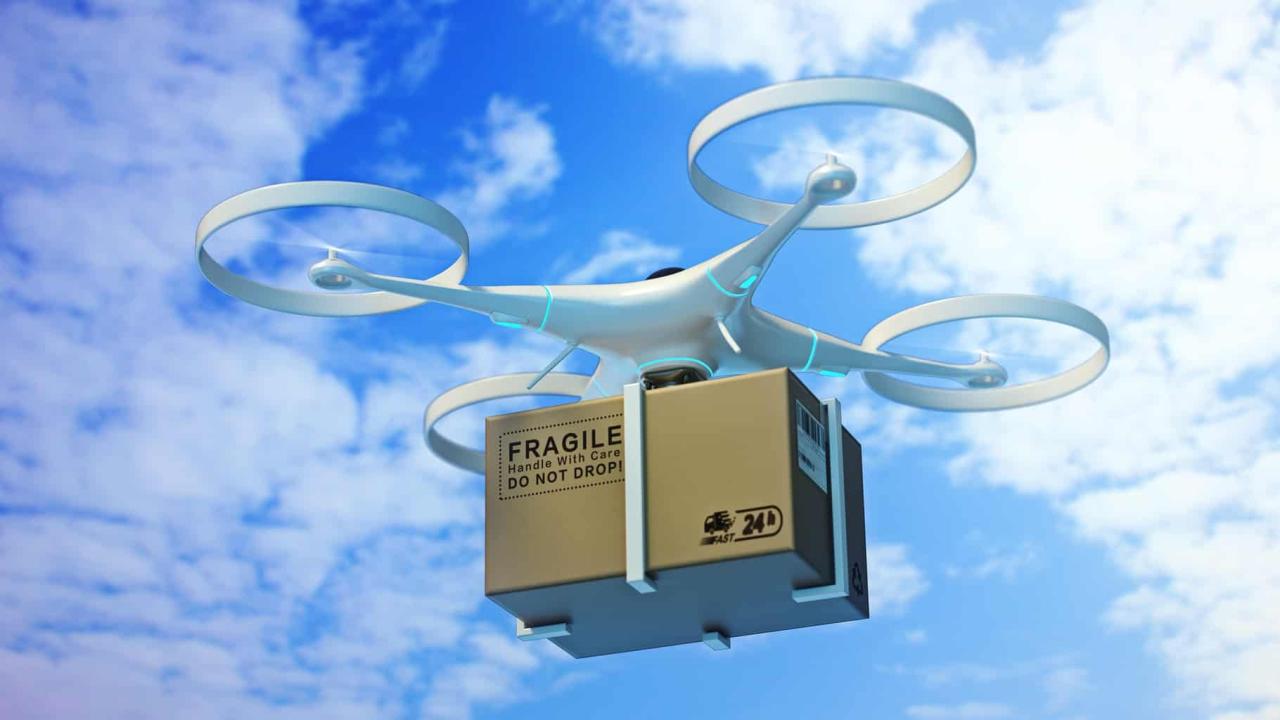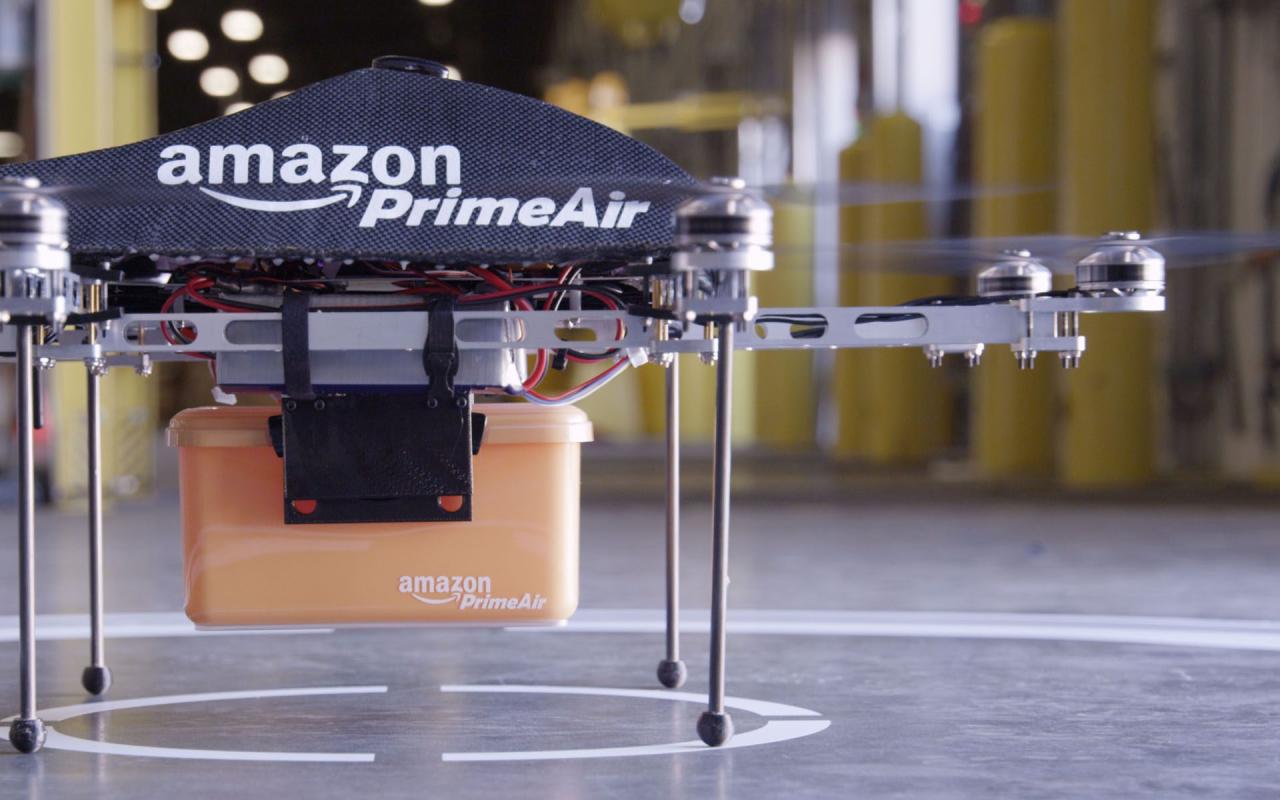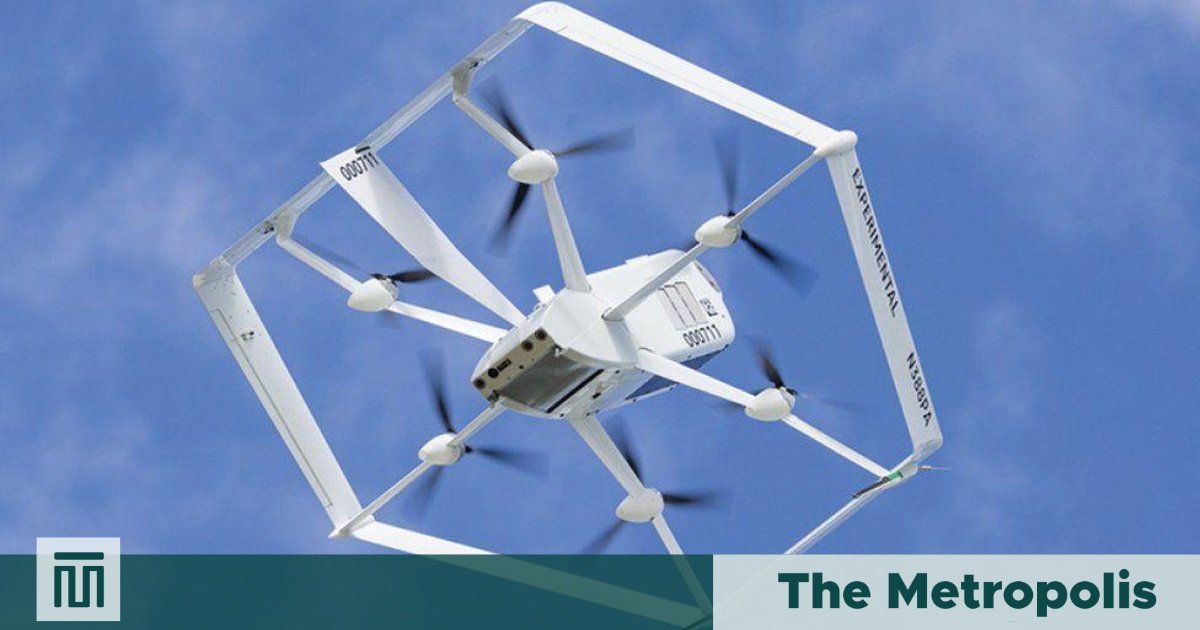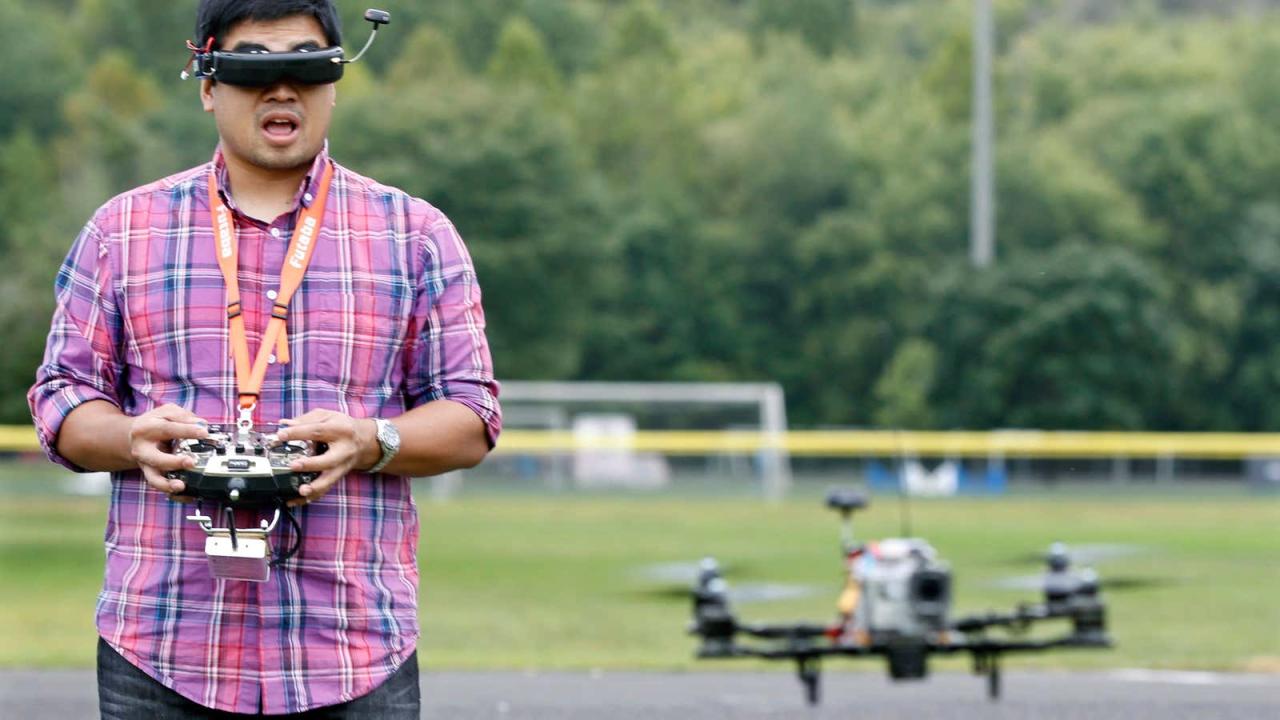Amazon drone delivery locations are rapidly expanding, transforming how we receive packages. This isn’t just about faster delivery; it’s a revolution in logistics, impacting urban planning, job markets, and even the environment. We’ll explore the current state of Amazon’s drone delivery program, examining the factors influencing location selection, the technology behind it, and its broader societal impact.
From the criteria Amazon uses to select locations—considering factors like population density, infrastructure, and regulations—to the technological marvels enabling safe and efficient drone operations, we’ll unpack the complexities of this innovative delivery system. We’ll also delve into community concerns, economic implications, and future projections for this game-changing technology.
Current Amazon Drone Delivery Program Status
Amazon’s drone delivery program, known as Amazon Prime Air, is steadily expanding its reach, aiming to revolutionize the speed and efficiency of package delivery. While still in its relatively early stages, the program has demonstrated significant progress and offers a glimpse into the future of logistics. The service is not yet available everywhere, and eligibility depends on several factors, including location and package type.Amazon Prime Air’s geographical scope is currently limited.
The service operates in select locations across the United States, primarily focusing on suburban and rural areas. This strategic approach allows Amazon to test and refine its technology in controlled environments before scaling up to more densely populated urban areas, which present unique challenges in terms of airspace management and regulatory compliance. The program is currently not operational internationally.
Geographical Scope of Amazon Drone Delivery
Currently, Amazon Prime Air operates in a limited number of states in the US. Precise locations are not always publicly released by Amazon due to operational and security considerations. However, publicly available information suggests that operations are concentrated in areas with less dense air traffic and favorable regulatory environments. Expansion plans, however, indicate a broader reach in the coming years.
The selection criteria for new locations include factors such as population density, infrastructure availability, and regulatory approvals.
Eligible Package Types for Drone Delivery
Not all packages are suitable for drone delivery. Amazon currently restricts drone delivery to smaller, lighter packages. This is due to the weight and size limitations of the drones themselves, as well as safety considerations. Typically, eligible packages contain everyday items such as household goods, books, and smaller electronics. Larger, heavier, or fragile items are excluded to maintain safety and delivery reliability.
Amazon continuously evaluates and may expand the range of eligible items as drone technology advances.
Infrastructure Requirements for Amazon Drone Delivery Locations
Successful drone delivery requires a robust infrastructure. This includes dedicated landing zones, often located on private property with sufficient space and clear approaches. These landing zones need to be clearly marked and safe from obstructions. Furthermore, strict adherence to airspace regulations is paramount. Amazon works closely with the Federal Aviation Administration (FAA) to ensure compliance with all relevant regulations, including flight paths, altitudes, and safety protocols.
Real-time monitoring and communication systems are crucial for safe and efficient operations, along with backup plans for unforeseen circumstances such as bad weather.
Timeline of Program Expansion
Amazon has not publicly released a detailed timeline for Prime Air expansion beyond stating a commitment to continue expanding the service. However, based on their current operational areas and public statements, it’s reasonable to expect a gradual rollout to additional locations in the coming years. This expansion will likely focus on areas where the necessary infrastructure is already in place or can be easily established, and where regulatory approvals are readily obtainable.
Successful expansion will hinge on addressing technological advancements, overcoming logistical hurdles, and securing necessary regulatory approvals.
Amazon’s expanding drone delivery network is aiming for more locations, but safety is key. Recent incidents, like the drone crash in Paris , highlight the challenges of widespread drone use. Understanding these risks is crucial for Amazon as they continue to develop and refine their drone delivery program for future expansion.
Factors Influencing Location Selection

Amazon’s drone delivery program, while innovative, faces significant logistical hurdles. Successful implementation hinges on careful selection of launch locations, considering a complex interplay of factors. These factors determine the feasibility, efficiency, and ultimately, the profitability of drone delivery operations in a given area.Choosing the right location isn’t simply about finding a place with enough customers; it’s about creating a sustainable and scalable delivery network.
Several key criteria guide Amazon’s decision-making process, balancing operational efficiency with regulatory compliance and community needs.
Key Criteria for Location Selection
Amazon prioritizes locations that offer a combination of high population density, suitable infrastructure, and a favorable regulatory environment. High population density ensures a sufficient customer base to justify the investment in drone delivery infrastructure. Suitable infrastructure includes readily available airspace, reliable communication networks, and convenient package handling facilities. A supportive regulatory framework minimizes operational restrictions and ensures compliance with safety standards.
Areas with existing strong e-commerce activity and a willingness to embrace new technologies are also favored. For example, a suburban area with established residential communities and good internet connectivity would be a prime candidate, whereas a remote, sparsely populated area with limited infrastructure would present significant challenges.
Urban Versus Rural Location Feasibility, Amazon drone delivery locations
Urban and rural areas present contrasting challenges for drone delivery. Urban environments offer high population density and established infrastructure but also pose complexities such as congested airspace, tall buildings, and stringent regulations. Rural areas, conversely, offer more open airspace and less regulatory hurdles but suffer from lower population density, limited infrastructure, and greater distances between delivery points. A successful strategy requires tailoring the approach to the specific characteristics of each environment.
For example, in densely populated urban areas, Amazon might utilize smaller, more maneuverable drones and advanced flight control systems to navigate complex airspace. In rural areas, longer-range drones with increased payload capacity might be more suitable, though this necessitates more robust communication infrastructure.
Logistical Challenges in Diverse Geographical Settings
Establishing drone delivery across diverse geographical settings presents unique logistical hurdles. Mountainous terrain, for instance, can impact drone range and flight stability, requiring drones with advanced capabilities. Extreme weather conditions like heavy rain, snow, or strong winds can severely restrict operations, demanding robust weather monitoring systems and contingency plans. Furthermore, maintaining consistent communication with drones in remote or challenging environments requires a resilient network infrastructure.
Addressing these challenges requires investments in advanced drone technology, robust communication systems, and skilled operational personnel. For example, Amazon might need to invest in weather-resistant drones and develop sophisticated algorithms for autonomous flight in adverse conditions.
Hypothetical Location Selection Model
A hypothetical model for selecting optimal drone delivery locations could incorporate a weighted scoring system. This system would assign weights to key criteria based on their relative importance. For example:
| Criterion | Weight | Score (0-10) | Weighted Score |
|---|---|---|---|
| Population Density | 0.3 | 8 | 2.4 |
| Infrastructure Quality | 0.25 | 7 | 1.75 |
| Regulatory Environment | 0.2 | 9 | 1.8 |
| Airspace Complexity | 0.15 | 4 | 0.6 |
| Existing E-commerce Activity | 0.1 | 6 | 0.6 |
Total Weighted Score: 7.15
Locations with higher total weighted scores would be considered more suitable for drone delivery. This model allows for a quantitative assessment of potential locations, enabling data-driven decision-making. The weights assigned to each criterion can be adjusted based on Amazon’s specific priorities and the characteristics of the target market.
Technological Aspects of Drone Delivery Locations

Amazon’s drone delivery program relies heavily on advanced technology to ensure safe and efficient operations. These technologies cover various aspects, from communication and navigation to safety protocols and emergency procedures, all tailored to the specific needs of each delivery location. The success of this program hinges on the seamless integration and robust performance of these technological components.
The technological infrastructure supporting Amazon’s drone delivery network is complex and multifaceted. It involves a sophisticated interplay of hardware and software designed to optimize efficiency, safety, and reliability across diverse operational environments.
Communication Systems
Reliable communication is crucial for real-time monitoring and control of drones. Amazon utilizes a network of ground stations and cellular/satellite communication systems to maintain constant contact with each drone throughout its flight. This allows for continuous monitoring of the drone’s status, location, and performance, enabling operators to intervene if necessary. The system incorporates redundancy to ensure uninterrupted communication even in areas with limited cellular coverage.
Data transmitted includes flight parameters, battery levels, and GPS coordinates.
Navigational Technologies
Precise navigation is paramount for safe and accurate deliveries. Amazon’s drones employ a combination of GPS, inertial measurement units (IMUs), and advanced sensor systems for precise positioning and obstacle avoidance. GPS provides the drone’s overall location, while IMUs measure its orientation and movement. These data are fused with information from cameras and other sensors to create a comprehensive situational awareness picture, enabling the drone to navigate complex environments and avoid collisions.
Advanced algorithms further enhance navigation accuracy and efficiency.
Safety Protocols and Emergency Procedures
Safety is the top priority. Amazon’s drone delivery locations are designed with multiple layers of safety protocols. These include pre-flight checks, real-time monitoring by trained personnel, and automated emergency landing systems. In case of communication failure or other unforeseen events, the drone is programmed to return to its designated launch site or execute an emergency landing procedure at a safe location.
Emergency response plans are in place to deal with any potential incidents. Furthermore, each delivery location is carefully assessed for potential hazards and flight restrictions are implemented to mitigate risks.
Drone Models and Terrain Suitability
The choice of drone model depends heavily on the terrain and operational requirements of each delivery location. Amazon utilizes a variety of drones, each optimized for specific conditions.
| Drone Model | Payload Capacity (kg) | Max Flight Range (km) | Terrain Suitability |
|---|---|---|---|
| Model A (Example) | 2 | 15 | Suburban, urban areas with minimal obstacles |
| Model B (Example) | 5 | 25 | Rural areas, longer distances, varied terrain |
| Model C (Example) | 1 | 10 | Dense urban environments, confined spaces |
| Model D (Example) | 3 | 20 | Moderate terrain, balance between range and payload |
Community Impact and Public Perception
Amazon’s drone delivery program, while offering the promise of faster and more efficient delivery, also presents a number of challenges and opportunities related to community impact and public perception. Successful implementation requires careful consideration of resident concerns and proactive engagement strategies to build trust and acceptance. This section explores the multifaceted relationship between Amazon’s drone delivery program and the communities it serves.Amazon’s community engagement strategies vary depending on the specific location, but generally involve a multi-pronged approach.
For example, in some areas, Amazon has held public forums and information sessions to directly address resident concerns and answer questions about noise levels, privacy, and safety protocols. They may also partner with local organizations and community leaders to disseminate information and build relationships. In other instances, Amazon may utilize online platforms and social media to engage with the public and provide updates on the program’s progress.
The goal is to foster open communication and transparency, building confidence in the safety and reliability of the drone delivery system.
Resident Concerns Regarding Drone Deliveries
Concerns about noise pollution are frequently raised by residents. The whirring sound of drones, especially during frequent deliveries, can be disruptive, particularly in quieter residential areas. Privacy is another significant concern. Many people worry about the potential for drones to capture images or videos of their property, raising concerns about surveillance and data security. Safety is also paramount; residents are naturally concerned about the potential for accidents, such as drone malfunctions or collisions.
These anxieties need to be addressed proactively through clear communication, robust safety protocols, and transparent data handling policies.
Potential Benefits and Drawbacks of Drone Delivery for Communities
The introduction of drone delivery presents both advantages and disadvantages for communities. It’s crucial to weigh these factors carefully to assess the overall impact.
- Benefits: Increased convenience and speed of delivery, reduced traffic congestion, potential for job creation in drone operation and maintenance, improved access to goods and services in remote or underserved areas.
- Drawbacks: Noise pollution, privacy concerns, safety risks, potential job displacement in traditional delivery sectors, increased energy consumption and environmental impact (though this is being addressed by Amazon, as detailed below).
Addressing Environmental Impact Concerns
Amazon acknowledges the environmental impact of drone deliveries, particularly concerning energy consumption and emissions. To mitigate these concerns, Amazon is actively investing in the development of more efficient and environmentally friendly drones. This includes focusing on electric-powered drones, optimizing flight paths to minimize energy use, and exploring the use of sustainable materials in drone construction. Furthermore, Amazon is committed to carbon offsetting initiatives to compensate for the unavoidable emissions associated with its drone delivery operations.
They are also exploring alternative fuels and technologies to further reduce their environmental footprint. While complete elimination of environmental impact may not be immediately achievable, Amazon’s efforts demonstrate a commitment to minimizing the negative consequences.
Economic and Business Implications: Amazon Drone Delivery Locations
Drone delivery presents a significant opportunity to reshape the economic landscape of communities chosen for Amazon’s program. The potential benefits extend beyond simply faster delivery; they encompass job creation, increased business efficiency, and enhanced competitiveness for both Amazon and local businesses. This section will explore these economic and business implications in detail.
The economic benefits of drone delivery are multifaceted. For businesses, the primary advantage lies in reduced delivery costs and increased efficiency. Faster delivery times translate to quicker inventory turnover, allowing businesses to optimize stock levels and reduce warehousing expenses. This is particularly beneficial for perishable goods or time-sensitive products. Furthermore, expanded delivery reach, especially to more remote areas previously underserved by traditional delivery methods, opens new markets and customer bases for businesses.
Job Creation in Drone Delivery Operations
The implementation of drone delivery creates numerous job opportunities, ranging from highly skilled roles to entry-level positions. These include drone pilots, maintenance technicians, software engineers, data analysts, and logistics managers. The creation of these jobs stimulates local economies, providing employment opportunities and boosting overall economic activity. Amazon’s investment in training and development programs for these roles further enhances the positive economic impact.
For example, a recent study estimated that for every 100 drones deployed, approximately 50-75 new jobs could be created across various roles in the supply chain.
Competitive Advantages for Amazon
Amazon’s drone delivery program offers several competitive advantages. The most significant is the potential to undercut competitors on delivery speed and cost. This enhanced speed and efficiency attracts customers seeking faster and more convenient delivery options, strengthening brand loyalty and potentially drawing customers away from competitors. The program also allows Amazon to penetrate new markets and expand its reach into areas where traditional delivery infrastructure is limited or expensive.
This expansion allows Amazon to tap into new customer bases and maintain a leading position in the e-commerce market. The unique technological prowess demonstrated also enhances Amazon’s reputation as an innovator and leader in the logistics sector.
Hypothetical Case Study: A Small Bookstore in a Rural Town
Let’s consider “The Book Nook,” a small independent bookstore in a rural town in Montana. Currently, shipping costs are high due to the distance from major distribution centers, and delivery times are slow, limiting their online sales potential. With Amazon drone delivery, “The Book Nook” could offer same-day or next-day delivery within a 25-mile radius, significantly expanding their market reach.
This could lead to a 20% increase in online sales within the first year, translating to an additional $10,000 in revenue, based on their current annual online sales of $50,000. Reduced shipping costs, estimated at 30% savings, would further enhance their profitability, leading to an overall increase in net income. This example illustrates the potential for drone delivery to revitalize small businesses in underserved areas.
Future Trends and Projections

Amazon’s drone delivery program is still in its relatively early stages, but its potential for growth and impact on various sectors is immense. Over the next decade, we can expect significant advancements in technology, regulation, and urban planning, all shaping the future landscape of drone delivery.
Predicting the future is inherently uncertain, but by analyzing current trends and technological advancements, we can paint a plausible picture of Amazon’s drone delivery network expansion over the next 5-10 years. We’ll examine technological improvements, regulatory changes, and the transformative impact on urban logistics.
Projected Expansion of Amazon’s Drone Delivery Network
Amazon’s initial rollout has focused on limited geographic areas, prioritizing locations with favorable conditions like relatively flat terrain and manageable airspace. However, within the next 5 years, we can expect a substantial expansion into more densely populated suburban and even some urban areas. This expansion will be driven by technological advancements allowing for safer and more efficient operations in complex environments.
Amazon’s expanding drone delivery network is aiming for more locations, but safety’s key. Think about the potential impact of incidents like the one described in this article about the orlando drone show accident ; it highlights the need for robust safety protocols and reliable technology before widespread drone deliveries become the norm. Therefore, careful planning and testing are crucial for Amazon’s drone delivery locations to succeed.
By year 10, we might see widespread drone delivery coverage across major metropolitan areas, particularly in regions with existing strong Amazon infrastructure and supportive regulatory frameworks, perhaps mirroring the current expansion of their ground-based delivery networks, but with a much faster rate of growth due to the inherent speed advantages of drone delivery. Think of a scenario where a significant portion of package deliveries in cities like Dallas or Phoenix are handled by drones, especially for smaller, time-sensitive items.
Technological Advancements in Drone Delivery
Several technological advancements will be crucial for enhancing the efficiency and safety of drone delivery. Improved battery technology is paramount, extending flight range and reducing the frequency of recharging. This could involve advancements in battery chemistry or the development of more efficient power systems. Advanced sensor technology, including sophisticated obstacle avoidance systems utilizing AI and machine learning, will be vital for navigating complex urban environments safely.
This includes better integration with existing air traffic control systems to prevent mid-air collisions. Furthermore, the development of more robust and reliable drone designs, capable of withstanding various weather conditions and carrying heavier payloads, will be key. For example, drones equipped with advanced weather sensors that allow them to autonomously adjust flight plans to avoid storms or high winds will be essential for reliability.
So you’re curious about where Amazon’s delivering packages via drone? It’s a pretty cool system! To get a good overview of the current operational areas, check out this constantly updated map of amazon drone delivery locations. This will give you a clear picture of which cities and towns are currently benefiting from this futuristic delivery method.
Amazon’s drone delivery program is expanding rapidly, so keep an eye on this resource to see where it goes next!
Influence of Changing Regulations on Drone Delivery Locations
The regulatory landscape surrounding drone operations is constantly evolving. As regulations become more streamlined and permissive, more areas will become suitable for drone delivery. Standardization of airspace management systems, the development of clear operational guidelines, and the establishment of designated drone delivery corridors will all play a significant role. Conversely, stricter regulations in certain areas, particularly concerning privacy or safety concerns, could limit the expansion of drone delivery services in those specific locations.
For instance, the establishment of no-fly zones near sensitive infrastructure or densely populated areas might restrict drone access. The successful integration of drone delivery will hinge on the ability of regulatory bodies to create a balance between facilitating innovation and ensuring public safety.
Reshaping Urban Planning and Logistics with Autonomous Delivery Systems
The widespread adoption of autonomous drone delivery systems will necessitate changes in urban planning and logistics. Cities may need to incorporate designated drone landing zones and charging stations into their infrastructure. This could involve redesigning rooftops, repurposing existing structures, or creating dedicated infrastructure in less-utilized spaces. The integration of drone delivery into existing logistics networks will require significant coordination between delivery companies, municipalities, and other stakeholders.
For example, imagine urban areas designing dedicated drone highways, much like elevated roadways for vehicles, to improve efficiency and safety. This would involve a significant overhaul of urban planning and infrastructure investment, but the potential benefits in terms of reduced traffic congestion and faster delivery times could be substantial.
Closing Summary

Amazon’s drone delivery program is more than just a faster way to get your packages; it’s a testament to technological innovation reshaping modern logistics. While challenges remain, the potential benefits—from economic growth to improved efficiency—are undeniable. As the program expands, we can expect to see even more sophisticated technology, improved safety measures, and a wider reach, fundamentally altering how we think about delivery services in the years to come.
FAQ Resource
What types of packages are currently eligible for drone delivery?
Currently, Amazon’s drone delivery program handles smaller, lighter packages. The exact weight and size limitations vary.
How does Amazon ensure the safety of drone deliveries?
Amazon employs sophisticated safety protocols, including advanced navigation systems, multiple redundancies, and rigorous testing. They also work closely with aviation authorities to ensure compliance with all regulations.
What about noise pollution from the drones?
Amazon is actively working to minimize noise pollution through the use of quieter drone designs and optimized flight paths. This is an ongoing area of development.
What are the job opportunities created by Amazon drone delivery?
The program creates jobs in drone operation, maintenance, software development, and logistics management, among other areas.
